|
How
to make your own custom wooden frames for your artwork, portraits and
photographs by Colette
Theriault |
|
Useful Tools &
Hardware |
| |
|
|
|
. |
|
Clamp Mate Frame Clamp |
|
 |
|
Economical Brad Setter |
|
 |
|
Frame Master Point Driver |
|
 |
|
Mat Mate Cutter System |
|
 |
|
Traditional Oak Picture
Frame Molding |
| |
| |
| |
| |
| |
| |
| |
| |
| |
| |
| |
| |
| |
|
|
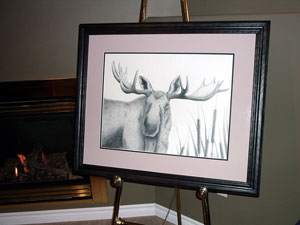 |
|
|
|
Most of us don't
have the professional equipment required to make a wooden picture frame with
a custom profile. This is why we buy most frames already made. However, you
can achieve surprisingly good results using common tools found in most
woodworkers' shop. The following article takes you through the process
of making such a frame using only a table saw, a router and a combination of
different router bits.
The frame we used
for this example was made from black ash and was for my
"moose" drawing that
measured 25 1/4" high by 31 1/4" long. We made the frame larger than the
actual drawing because I used double matting to complement the picture.
Consequently, the outside frame dimensions were 29" high by 35" long.
Another point we considered was that the larger is the frame, the wider the
side pieces should be. We chose a width of 2 1/4".
Using the table saw, we
cut one piece from 3/4" stock of solid wood that measured 5" by 38" and
another piece that measured 5" by 32". Note that we allowed 3 extra inches
along the length of each piece to compensate for final adjustments. When
you have decided on the dimensions for your frame, make sure you add a few
extra inches to the length. Also, once you have chosen the width of the
frame pieces, you double that measurement and add 1/2". For example, for my
frame, we chose a width of 2 1/4". We then multiplied by 2 to get 4 1/2".
To compensate for trimming, we added an extra 1/2" to get our cut
measurement of 5".
Now that we have
cut the pieces for the frame height and length, we chose the profile bits we
desired (see below). There are many different styles to choose from to suit
individual tastes. The profile was then achieved using a router mounted on
a table.
|
|


|
|
Profile bits (left to
right; rabbet bit, face molding bit, cove bit) for the "moose" frame. |
|
------------------------------------------------------------------------------ |
|
Step 1:Making the Frame
Profile
To make the face
profile, rout on both sides of each piece with the face molding bit (this is
the face of the frame i.e. good side).
|
|
|
|
Click on the images
below to view/purchase the face molding (profile) bit used to make this frame. Face
molding bit is 1 3/8" high with 1/2" shank. |
|

 |
|
------------------------------------------------------------------------------ |
|
Step 2:Making the Rabbet
Profile
Flip the pieces
over (back of frame). To make the rabbet profile, rout on both sides of each
piece. This is where the glass will sit on the inside of the frame (3/8"
rabbet is recommended).
|
|
|
|
Click on the images
below to view/purchase the rabbet bit used to make this frame. Rabbet
bit used is 3/8" with 1/2" shank. |
|

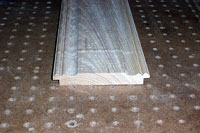 |
|
------------------------------------------------------------------------------ |
|
Step 3:Ripping the Pieces
You can now rip
each piece to the desired width measurement (i.e. 2 1/4" for my frame). You
now have the four pieces required for your frame.
|
|
|
|

 |
|
------------------------------------------------------------------------------ |
|
Step 4:Making the Cove Edge
This step involves
making the cove edge on the outside of the frame pieces. This is the final
pass required to complete the frame profile.
|
|
Click on the images
below to view/purchase the cove bit used to make this frame. Cove bit
used is 3/8" with
1/2" shank. |
|
|
|

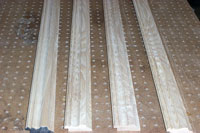 |
|
------------------------------------------------------------------------------ |
|
Step 5:Cutting the Frame
Once all pieces have
the desired profile, we can proceed to cutting the frame. All 45 degree cuts
were made using a laser guided miter saw equipped with proper support. You
can also use a table saw, using your miter guide. It is recommended that
you test your miter cuts on scrap pieces of wood until you get a good
fitting joint. Mark the exact location on your guide (it may not be exactly
45 degrees).
|
|
|
|

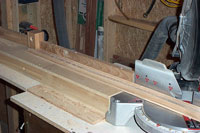 |
|
Using your reference mark, cut
a 45 degree angle at one end of each piece. You now have to make a 45
degree angle cut at the other end of each piece so that the frame is
to the proper dimension. Starting with one piece that makes up the
frame length, make repetitive miter cuts in order to achieve the
desired length (measure the length desired inside the rabbet cut).
Once the desired length is reached for one piece, use a stop block to
measure for the second piece. Now, make the 45 degree cut for the two
pieces that make up the height of the frame. |
|
------------------------------------------------------------------------------ |
|
Fastening the Frame
The frame has been cut to
proper size and we are now ready to fasten the joints. There are various
techniques to fastening miter joints. Using mechanical fasteners like
corrugated nails, chevrons or tack plates is probably the simplest way but
is only recommended for softwood. This is because the fasteners tend to
crumple when driven into hardwood and can cause the wood or joint to
split. Another method is to use open splines or biscuits. However,
depending on the profile of your frame, you may not be able to use these
because the profile would be ruined. The last method for securing miter
joints uses wood plugs. We chose this method because it is relatively easy
to accomplish and also creates a strong and stable joint.
|
|
|
|
Click on images
to view/purchase the quick release picture framing clamp. |
|

 |
|
Step 1:Gluing and Clamping
the Frame
Clamp the frame
together using a picture frame clamp, miter clamp or similar device. Apply
glue to the joint and clamp the frame for 24 hours to allow the glue to dry.
Unclamp the frame before proceeding to step 2.
|
|
------------------------------------------------------------------------------ |
|
Step 2:Reinforcing the
Joints with Dowel Plugs
In order to reinforce
the miter joint, drill a 1" diameter hole, 1/4" deep in each corner of the
frame using a Forstner bit. Those holes will be covered with plugs that can be made from 1"
dowels. If possible, make the plugs with the same material as the frame.
You then apply glue in the holes and cover the holes with the wood plugs.
At this point, clamps are not necessary since the miter joints are already
glued together.
|
|
|
|

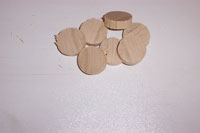
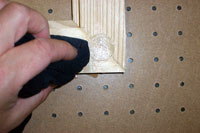 |
|
------------------------------------------------------------------------------ |
|
Step 3:Wipe the Glue
Wipe the excess
glue with a clean, humid cloth. Wait 24 hours for the glue to dry
completely and proceed to the finishing process.
|
|
|
|
Click on images
to view/purchase quality carpentry glue. |
|

 |
|
------------------------------------------------------------------------------ |
|
Finishing the Frame
Step 1: Sanding the Frame
Make sure the wood
is sanded nice and smooth and that all trace of dust is removed with a tack
cloth. Remove any residual glue and sand with a fine grit sand paper
(150-180 grit).
|
|
------------------------------------------------------------------------------ |
|
Step 2:Decide on the
Finished "Look" of your Frame
Decide on the finished
look you want for the frame. You can keep the wood natural, stain it or
even paint it. Below are some examples of the different profiles and
finishes used to frame various pieces of my artwork (color may vary
depending on type of wood used).
|
|

 |
|
Minwax Polyshade
(stain and varnish combination) Classic Oak#470 on black ash.
|
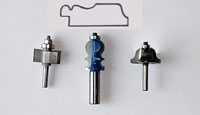 |
|
Profile bits (left to
right; rabbet bit, face molding bit, roman ogee bit) for "fox" frame.
|
|
------------------------------------------------------------------------------ |
|
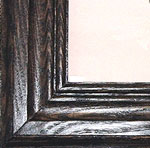
 |
|
Minwax Wood Finish
(stain) Ebony#2718 on red oak (sealed with Flecto water-based
varathane). |
|
 |
|
Profile Bits (left to
right; rabbet bit, face molding bit, roman ogee bit) for "horse" frame. |
|
------------------------------------------------------------------------------ |
|
Step 3:Apply
the Finish and Seal the Wood
Apply the finish as per instructed on the can label. Always sand lightly
between coats with the finest sandpaper. This ensures a smooth finish for
subsequent applications. If applying a stain, you must seal the wood after
the stain is dry. I prefer to use a water-based clear polyurethane finish
called Varathane (by Flecto). It is low odor, water clean-up and doesn't
yellow. If you want natural wood, this is also the perfect finish, however,
sanding is a must between coats because water-based finishes lifts the grain
is some wood species. For the "moose" frame shown in this article, I first
stained the wood with Minwax Wood Finish Ebony#2718, then applied Flecto
Varathane clear satin finish (water based) to seal the wood.
|
|
|
|
Please do not reproduce,
distribute or copy this article without written consent by the author. |